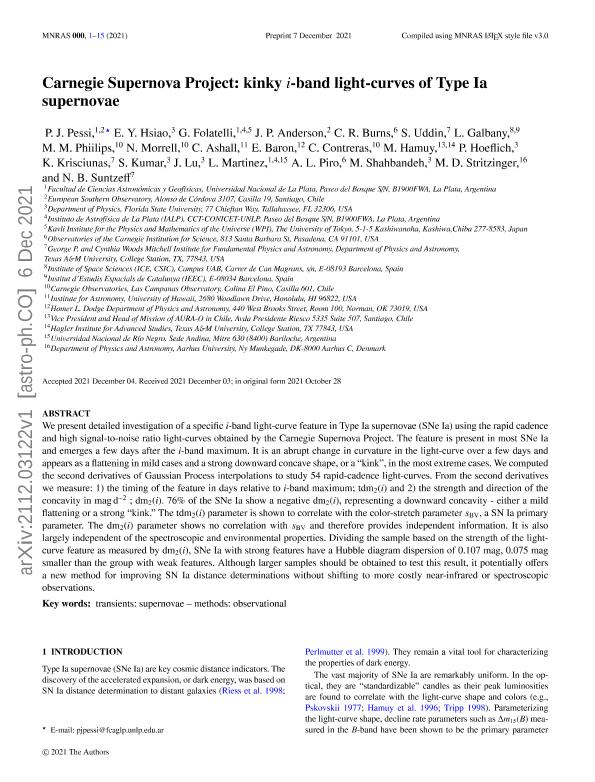Artículo
Carnegie Supernova Project: Kinky i-band light curves of Type Ia supernovae
Pessi, Priscila Jael ; Hsiao, E. Y.; Folatelli, Gaston
; Hsiao, E. Y.; Folatelli, Gaston ; Anderson, J. P.; Burns, C. R.; Uddin, S.; Galbany, L.; Phillips, M. M.; Morrell, N.; Ashall, C.; Baron, E.; Contreras, C.; Hamuy, M.; Hoeflich, P.; Krisciunas, K.; Kumar, S.; Lu, J.; Martinez, Laureano
; Anderson, J. P.; Burns, C. R.; Uddin, S.; Galbany, L.; Phillips, M. M.; Morrell, N.; Ashall, C.; Baron, E.; Contreras, C.; Hamuy, M.; Hoeflich, P.; Krisciunas, K.; Kumar, S.; Lu, J.; Martinez, Laureano ; Piro, A. L.; Shahbandeh, M.; Stritzinger, M. D.; Suntzeff, N. B.
; Piro, A. L.; Shahbandeh, M.; Stritzinger, M. D.; Suntzeff, N. B.
 ; Hsiao, E. Y.; Folatelli, Gaston
; Hsiao, E. Y.; Folatelli, Gaston ; Anderson, J. P.; Burns, C. R.; Uddin, S.; Galbany, L.; Phillips, M. M.; Morrell, N.; Ashall, C.; Baron, E.; Contreras, C.; Hamuy, M.; Hoeflich, P.; Krisciunas, K.; Kumar, S.; Lu, J.; Martinez, Laureano
; Anderson, J. P.; Burns, C. R.; Uddin, S.; Galbany, L.; Phillips, M. M.; Morrell, N.; Ashall, C.; Baron, E.; Contreras, C.; Hamuy, M.; Hoeflich, P.; Krisciunas, K.; Kumar, S.; Lu, J.; Martinez, Laureano ; Piro, A. L.; Shahbandeh, M.; Stritzinger, M. D.; Suntzeff, N. B.
; Piro, A. L.; Shahbandeh, M.; Stritzinger, M. D.; Suntzeff, N. B.
Fecha de publicación:
03/2022
Editorial:
Wiley Blackwell Publishing, Inc
Revista:
Monthly Notices of the Royal Astronomical Society
ISSN:
0035-8711
Idioma:
Inglés
Tipo de recurso:
Artículo publicado
Clasificación temática:
Resumen
We present detailed investigation of a specific i-band light-curve feature in Type Ia supernovae (SNe Ia) using the rapid cadence and high signal-to-noise ratio light curves obtained by the Carnegie Supernova Project. The feature is present in most SNe Ia and emerges a few days after the i-band maximum. It is an abrupt change in curvature in the light curve over a few days and appears as a flattening in mild cases and a strong downward concave shape, or a 'kink', in the most extreme cases. We computed the second derivatives of Gaussian Process interpolations to study 54 rapid-cadence light curves. From the second derivatives we measure: (1) the timing of the feature in days relative to i-band maximum; tdm2(i) and (2) the strength and direction of the concavity in mag d-2; dm2(i). 76 per cent of the SNe Ia show a negative dm2(i), representing a downward concavity - either a mild flattening or a strong 'kink'. The tdm2(i) parameter is shown to correlate with the colour-stretch parameter sBV, a SN Ia primary parameter. The dm2(i) parameter shows no correlation with sBV and therefore provides independent information. It is also largely independent of the spectroscopic and environmental properties. Dividing the sample based on the strength of the light-curve feature as measured by dm2(i), SNe Ia with strong features have a Hubble diagram dispersion of 0.107 mag, 0.075 mag smaller than the group with weak features. Although larger samples should be obtained to test this result, it potentially offers a new method for improving SN Ia distance determinations without shifting to more costly near-infrared or spectroscopic observations.
Palabras clave:
METHODS: OBSERVATIONAL
,
TRANSIENTS: SUPERNOVAE
Archivos asociados
Licencia
Identificadores
Colecciones
Articulos(IALP)
Articulos de INST.DE ASTROFISICA LA PLATA
Articulos de INST.DE ASTROFISICA LA PLATA
Citación
Pessi, Priscila Jael; Hsiao, E. Y.; Folatelli, Gaston; Anderson, J. P.; Burns, C. R.; et al.; Carnegie Supernova Project: Kinky i-band light curves of Type Ia supernovae; Wiley Blackwell Publishing, Inc; Monthly Notices of the Royal Astronomical Society; 510; 4; 3-2022; 4929-4942
Compartir
Altmétricas



